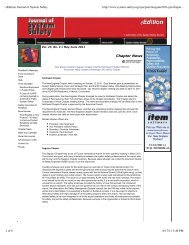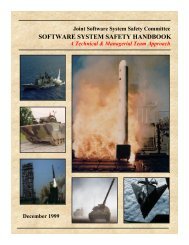Air Force System Safety Handbook - System Safety Society
Air Force System Safety Handbook - System Safety Society
Air Force System Safety Handbook - System Safety Society
Create successful ePaper yourself
Turn your PDF publications into a flip-book with our unique Google optimized e-Paper software.
4.1 <strong>System</strong> <strong>Safety</strong> Program Objectives<br />
and Requirements.<br />
Employing good management and engineering principles is<br />
the heart of the system safety function. It is the system safety<br />
program that integrates all these efforts and ensures a<br />
minimum risk weapon system consistent with other program<br />
constraints. A system safety program consists of a system<br />
safety plan, various specific management tasks, several<br />
time-phased analyses, and periodic reviews and evaluations.<br />
Chapter 5 will discuss the system safety plan in detail.<br />
Chapter 6 outlines other management tasks. Chapter 7<br />
reviews various analyses. Chapter 8 discusses the several<br />
assessment and verification tasks.<br />
In this chapter, the system safety program will be discussed in<br />
general. Chapter 1 explained the need for system safety, and<br />
Chapter 2, DOD and <strong>Air</strong> <strong>Force</strong> policy and participants in<br />
system safety efforts. These efforts are the systematic,<br />
well-defined process called a system safety program. It is<br />
fundamentally a management process employing certain<br />
engineering tasks.<br />
The principal objective of a system safety program within the<br />
DOD is to make sure safety, consistent with mission requirements,<br />
is designed into systems, subsystems, equipment,<br />
facilities, and their interfaces and operation. The degree of<br />
safety achieved in a system depends directly on management<br />
emphasis. Government agencies and contractors must apply<br />
management emphasis to safety during the system acquisition<br />
process and throughout the life cycle of each system, making<br />
sure mishap risk is understood and risk reduction is always<br />
considered in the management review process.<br />
A formal safety program that stresses early hazard identification<br />
and elimination or reduction of associated risk to a<br />
level acceptable to the managing activity is the principal contribution<br />
of effective system safety. The success of the system<br />
safety effort depends on definitive statements of safety objectives<br />
and requirements.<br />
Specific system safety program objectives are outlined in<br />
paragraph 1.2.<br />
Specific time-phased requirements will be discussed in<br />
Chapter 10. General system safety program requirements are:<br />
(30:3)<br />
a. Eliminate identified hazards or reduce associated<br />
risk through design, including material selection or<br />
substitution.<br />
b. Isolate hazardous substances, components, and<br />
operations from other activities, areas, personnel,<br />
and incompatible materials.<br />
c. Locate equipment so that access during operations,<br />
servicing, maintenance, repair, or adjustment<br />
minimizes personnel exposure to hazards.<br />
d. Minimize risk resulting from excessive<br />
environmental conditions (e.g., temperature,<br />
pressure, noise, toxicity, acceleration, and<br />
vibration).<br />
CHAPTER 4<br />
SYSTEM SAFETY PROGRAM<br />
27<br />
e. Design to minimize risk created by human error in<br />
the operation and support of the system.<br />
f. Consider alternate approaches to minimize risk from<br />
hazards that cannot be eliminated. Such<br />
approaches include interlocks, redundancy, fail-safe<br />
design, fire suppression, and protective clothing,<br />
equipment, devices, and procedures.<br />
g. Protect power sources, controls, and critical<br />
components of redundant subsystems by separation<br />
or shielding.<br />
h. When alternate design approaches cannot eliminate<br />
the hazard, provide warning and caution notes in<br />
assembly, operations, maintenance, and repair<br />
instructions, and distinctive markings on hazardous<br />
components and materials, equipment, and facilities<br />
to ensure personnel and equipment protection.<br />
These shall be standardized in accordance with MA<br />
requirements.<br />
i. Minimize the severity of personnel injury or damage<br />
to equipment in the event of a mishap.<br />
j. Design software-controlled or monitored functions to<br />
minimize initiation of hazardous events or mishaps.<br />
k. Review design criteria for inadequate or overly<br />
restrictive requirements regarding safety.<br />
Recommend new design criteria supported by<br />
study, analyses, or test data.<br />
Management Responsibilities. <strong>System</strong> safety management<br />
(especially in the program office), in order to meet the<br />
objectives and requirements of system safety, must:<br />
(29:A1-A2)<br />
a. Plan, organize, and implement an effective system<br />
safety program that is integrated into all life cycle<br />
phases.<br />
b. Establish definitive system safety program<br />
requirements for the procurement or development of<br />
a system. The requirements must be set forth<br />
clearly in the appropriate system specifications and<br />
contractual documents.<br />
c. Ensure that a system safety program plan (SSPP) is<br />
prepared that reflects in detail how the total program<br />
is to be conducted.<br />
d. Review and approve for implementation the SSPPs<br />
prepared by the contractor.<br />
e. Supply historical safety data as available.<br />
f. Monitor contractors’ system safety activities and<br />
review and approve deliverable data, if applicable,<br />
to ensure adequate performance and compliance<br />
with system safety requirements.




